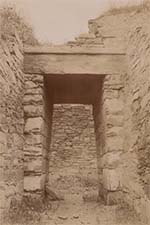Alan J. B. Wace, classicist and archaeologist, began his research in the region of Thessaly, Greece, in the wake of Christos Tsountas’ discoveries at the Neolithic sites of Dimini and Sesklo near Volos (published in 1908). From April 1905, Wace undertook study tours in the Volos area, also exploring the Pelion peninsula and the islands of Skiathos [AJBW/3/12/14] and Skopelos [AJBW/3/12/16]. Along with J.P. Droop, he excavated at Theotokou in 1907, identified as the possible ancient Greek city of Sepias [AJBW/3/11/49]. The site proved to contain some ‘Hellenic’ walls and early Geometric burials near a ruined Byzantine church.
In the following year, and in the company of Maurice Thompson, Wace and Droop excavated a magoula, or prehistoric mound, at Zerelia. Thereafter, no longer with Droop, who withdrew from the project owing to ill health, four other magoules were investigated in subsequent years: Lianokladi (in the Spercheios valley) and Tzani (near the location of Arne/Cierium) in 1909, Rakhmani (north of Larisa) and Tsangli (south of Larisa) in 1910. Central to Wace’s work in Thessaly was establishing a pottery sequence for the local Neolithic, building upon Tsountas’ initial work. This chronology would eventually be published in 1912, in Chapter 2 of Wace and Thompson’s Prehistoric Thessaly: Being Some Account of Recent Excavations and Explorations in North-eastern Greece from Lake Kopais to the Borders of Macedonia , Cambridge University Press, 1912.
Some of the highlights from the notebooks include detailed notes that Wace took on a study visit to the, then newly-established, Volos Museum in late 1909 ( GBR/3437/AJBW/1/16 ), as he began to bring together his pottery chronology and finalise the book’s text. Alongside sketches and transcriptions of museum labels, Wace also made detailed bibliographic notes and roughed out a first text that would eventually become the introduction to Prehistoric Thessaly .
Photographs from Wace’s album GBR/3437/AJBW/3/21 document both study tours of the area in 1909 as well as more general explorations north of the then-Greek border, documenting encounters with a group of migratory Vlachs from Samarina , and a New Year’s celebration spent in the villages. These observations and images of pastoral communities would feature in a second publication Wace wrote with Maurice S. Thompson, The Nomads of the Balkans. An Account of Life and Customs among the Vlachs of Northern Pindus , London, Methuen , 1914.
Wace worked at a frenetic pace during his twenties, gathering knowledge of the canonical archaeological sites of Classical civilisation in Greece and western Asia Minor (Turkey). He traversed a variety of Mediterranean landscapes, from mainland mountains, valleys and plains and the coastal littoral to Aegean and Ionian islands. Hence the two bound albums digitised for this project, GBR/3437/AJBW/3/11 and GBR/3437/AJBW/3/12 , contain photographs with a much broader geographical span than the region of Thessaly. Both albums have been digitised in their entirety, including pages with empty apertures but with Wace’s annotations, detailing the images that should reside there. In this way, we can both retrace his original itineraries and even fill in the visual gaps from duplicate photographs held in the British School at Athens archives.
The notebooks and images that orientate around Wace’s explorations in Thessaly between 1905 and 1910 are now lodged in three archive repositories in two countries, one and a half thousand miles apart: the Faculty of Classics and Pembroke College in Cambridge, England and the British School at Athens in Greece. Ideally, these records should be read sequentially as a sibling group, not as individual texts siloed in dispersed collections, to render the fullest possible contextual information. Digitisation has enabled this reunification over a century after the documents’ creation and seventy years since their separation.
More information on the Wace Thessaly notebooks held at the British School at Athens can be found here and at Pembroke College, University of Cambridge, here .
We are grateful to the Friends of the British School at Athens and Cambridge Digital Humanities for assisting financially with the digitisation of these records.


